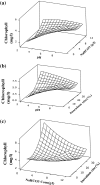Evaluation of photosynthetic efficacy and CO2 removal of microalgae grown in an enriched bicarbonate medium
- PMID: 28330079
- PMCID: PMC4701708
- DOI: 10.1007/s13205-015-0314-5
Evaluation of photosynthetic efficacy and CO2 removal of microalgae grown in an enriched bicarbonate medium
Erratum in
-
Erratum to: Evaluation of photosynthetic efficacy and CO2 removal of microalgae grown in an enriched bicarbonate medium.3 Biotech. 2016 Jun;6(1):77. doi: 10.1007/s13205-016-0374-1. 3 Biotech. 2016. PMID: 28330147 Free PMC article. No abstract available.
Abstract
Bicarbonate species in the aqueous phase is the primary source for CO2 for the growth of microalgae. The potential of carbon dioxide (CO2) fixation by Chlorella pyrenoidosa in enriched bicarbonate medium was evaluated. In the present study, effects of parameters such as pH, sodium bicarbonate concentration and inoculum size were assessed for the removal of CO2 by C. pyrenoidosa under mixotrophic condition. Central composite design tool from response surface methodology was used to validate statistical methods in order to study the influence of these parameters. The obtained results reveal that the maximum removal of CO2 was attained at pH 8 with sodium bicarbonate concentration of 3.33 g/l, and inoculum size of 30 %. The experimental results were statistically significant with R 2 value of 0.9527 and 0.960 for CO2 removal and accumulation of chlorophyll content, respectively. Among the various interactions, interactive effects between the parameters pH and inoculum size was statistically significant (P < 0.05) for CO2 removal and chlorophyll accumulation. Based on the studies, the application of C. pyrenoidosa as a potential source for carbon dioxide removal at alkaline pH from bicarbonate source is highlighted.
Keywords: Carbon concentrating mechanism; Chlorella pyrenoidosa; Dissolved inorganic carbon; Mixotrophic condition; Response surface methodology.
Conflict of interest statement
The authors declare that there is no conflict of interest.
Figures




Similar articles
-
Impacts of CO2 concentration on growth, lipid accumulation, and carbon-concentrating-mechanism-related gene expression in oleaginous Chlorella.Appl Microbiol Biotechnol. 2015 Mar;99(5):2451-62. doi: 10.1007/s00253-015-6397-4. Epub 2015 Jan 27. Appl Microbiol Biotechnol. 2015. PMID: 25620370
-
Inorganic carbon acquisition in the acid-tolerant alga Chlorella kessleri.Physiol Plant. 2015 Jan;153(1):175-82. doi: 10.1111/ppl.12228. Epub 2014 Jun 10. Physiol Plant. 2015. PMID: 24828745
-
Interactive effects of roxithromycin and freshwater microalgae, Chlorella pyrenoidosa: Toxicity and removal mechanism.Ecotoxicol Environ Saf. 2020 Mar 15;191:110156. doi: 10.1016/j.ecoenv.2019.110156. Epub 2020 Jan 17. Ecotoxicol Environ Saf. 2020. PMID: 31958625
-
The CO2 concentrating mechanism and photosynthetic carbon assimilation in limiting CO2 : how Chlamydomonas works against the gradient.Plant J. 2015 May;82(3):429-448. doi: 10.1111/tpj.12829. Plant J. 2015. PMID: 25765072 Review.
-
Serum Total Carbon Dioxide.In: Walker HK, Hall WD, Hurst JW, editors. Clinical Methods: The History, Physical, and Laboratory Examinations. 3rd edition. Boston: Butterworths; 1990. Chapter 196. In: Walker HK, Hall WD, Hurst JW, editors. Clinical Methods: The History, Physical, and Laboratory Examinations. 3rd edition. Boston: Butterworths; 1990. Chapter 196. PMID: 21250150 Free Books & Documents. Review.
Cited by
-
Optimization of nutrient stress using C. pyrenoidosa for lipid and biodiesel production in integration with remediation in dairy industry wastewater using response surface methodology.3 Biotech. 2018 Aug;8(8):326. doi: 10.1007/s13205-018-1342-8. Epub 2018 Jul 17. 3 Biotech. 2018. PMID: 30034990 Free PMC article.
References
-
- Amoroso G, Sultemeyer D, Thyssen C, Fock H. Uptake of HCO3− and CO2 in cells and chloroplasts from the microalgae Chlamydomonas reinhardtii and Dunaliella tertiolecta. Plant Physiol. 1998;116:193–201. doi: 10.1104/pp.116.1.193. - DOI
-
- American public health association (APHA) Standard methods for the examination of water and wastewater. 21. Washington: AWWA-WPCF; 2005.
-
- Becker EW. Microalgae: biotechnology and microbiology. NewYork: Cambridge University Press; 1994.
-
- Benemann JR. Utilization of carbon dioxide from fossil fuel-burning power plants with biological systems. Energy Convers Manag. 1993;34:999–1004. doi: 10.1016/0196-8904(93)90047-E. - DOI
LinkOut - more resources
Full Text Sources
Other Literature Sources

